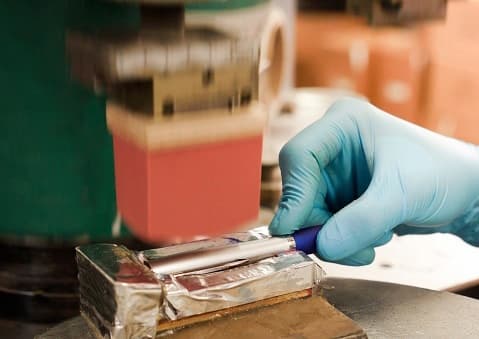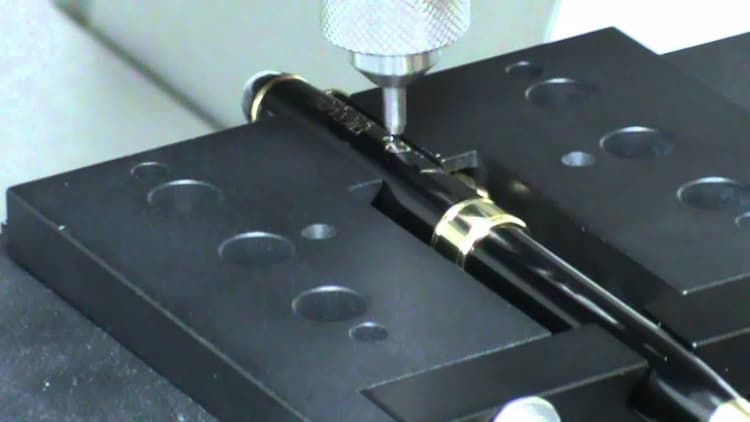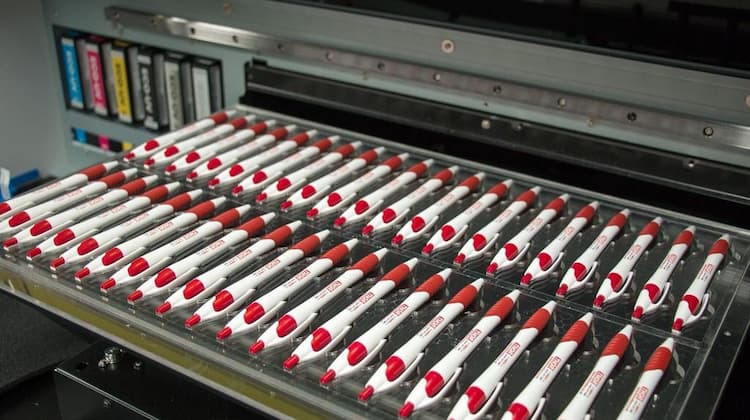
8 January, 2025
Custom Pen Printing Techniques: Choosing the Best for Your Brand
What sets a brand apart is not just the pen itself but the printing technique used to customise it. The right branding method can dramatically enhance the pen’s appeal, durability, and overall representation of your brand. But which pen branding technique works best for your brand? Read on to find some helpful tips.
1. Screen Printing
Process: Screen printing, also known as silk screening, involves creating a screen, typically a mesh, which is used as a stencil. The screen is placed on the pen, and ink is spread over it. The ink passes through the open areas of the stencil, transferring the design onto the pen's surface.
Colour Application: Each colour in the design requires a separate screen. The process is repeated for each colour, making it more suitable for designs with fewer colours.
Types of Pens Best Suited
Plastic Pens: Screen printing is particularly effective on plastic pens, as the ink adheres well to plastic surfaces.
Barrel Pens with Larger Surface Area: Pens with a larger barrel surface are ideal for screen printing, as they provide more space for the design and text.
Advantages
Economical for Bulk Orders: The cost-effectiveness increases with quantity, making it a good choice for large promotional campaigns.
Vibrant and Opaque Colours: It offers colours that are vibrant and stand out, especially on darker pen surfaces.
Limitations
Limited Colour Complexity: It’s not suitable for designs with gradients or a large number of colours due to the separate screen needed for each colour.
Less Detail in Design: Fine details may not be accurately reproduced, especially on smaller pen surfaces.

2. Pad Printing
Process: Pad printing involves transferring ink from a plate (cliché) to the pen using a soft silicone pad. The pad compresses onto the ink-filled etches on the plate and then transfers the ink onto the pen surface.
Versatility: This method allows printing on a variety of surfaces, including uneven and curved areas, making it versatile for different pen designs.
Types of Pens Best Suited
All Types Of Pens: It is suitable for all types of pens, as it can conform to the pen's contours and irregularities.
Pens with Textured Surfaces: The soft silicone pad can adapt to textured surfaces, making it ideal for pens with non-uniform designs.
Advantages
Detailed and Complex Designs: It is capable of reproducing detailed images and can handle multiple colours with precision.
Versatility in Surface Type: It’s effective on a variety of surfaces and shapes, including hard-to-print areas.
Limitations
Cost: The cost per unit is higher than screen printing, especially for smaller batches. The cost increases with the number of colours.
Durability: The printed design may wear off faster on high-use items, especially on surfaces like metal, where abrasion is more likely.

3. Laser Engraving
Process: Laser engraving uses a laser beam to remove the surface layer of the pen material, creating a precise and permanent design. The laser beam is controlled by a computer, allowing for highly detailed and accurate engraving.
Depth and Texture: The laser can etch at varying depths, creating a textured feel to the design, which adds a tactile quality to the pen.
Types of Pens Best Suited
Metal Pens: Ideal for engraving due to their durability. Logo-engraved metal pens often reveal a different colour underneath, adding contrast to the design.
Wooden Pens: Wood is a great material for this method of branding as it produces a burnt, rustic look that is highly sought after in premium and eco-friendly pen designs.
Advantages
Durability: The design is permanent and won't fade or rub off over time, making it ideal for pens that are used frequently.
Elegance and Sophistication: It gives a sophisticated and high-end look, significantly elevating the perceived value of the pen.
No Inks or Chemicals Used: This makes it an environmentally friendly option as there are no consumables other than the material of the pen itself.
Limitations
Monochrome Designs: Laser engraving does not allow for colour – it's best suited for designs that require only one colour.
Cost and Time: Generally more expensive due to the technology and time required, especially for intricate designs.

4. Digital Printing
Process: Digital printing involves applying ink directly onto the pen’s surface from a digital image file using inkjet or laser printers. This allows for full-colour, high-resolution printing directly on the pen.
Colour and Detail: Capable of reproducing full-colour images, including gradients and fine details, with a high degree of accuracy.
Types of Pens Best Suited
Smooth-Surfaced Pens: Ideal for pens with a smooth and flat surface, as it ensures clear and precise print quality.
Various Materials: Suitable for a range of materials including plastic, metal, and even rubber-coated pens.
Advantages
Versatility in Design: Allows for a wide range of designs, including full-colour photographs and intricate multi-coloured logos.
Quick Turnaround: Digital printing is fast, making it ideal for orders that require a quick delivery time.
Quality of Print: High-resolution printing results in sharp and clear images, making it suitable for complex designs that require attention to detail.
Limitations
Cost: Can be more expensive per unit than traditional printing methods like screen printing, especially for large orders.
Durability: The ink may wear off over time, especially with frequent use or exposure to certain elements.
Choosing the Right Technique for Your Brand
1. Brand Identity and Message
Aligning with Brand Aesthetics: The printing technique should complement your brand’s visual identity. For instance, a brand with a minimalist aesthetic might opt for laser engraving, which offers a subtle and refined look.
Conveying the Brand Message: Different printing techniques can convey different messages. Screen printing, with its bright and bold colours, could be ideal for a brand that wants to appear accessible and fun. Conversely, a brand wanting to convey sophistication and exclusivity might choose laser engraving.
Industry Considerations: The industry you operate in can also dictate the appropriate technique. A tech company might lean towards digital printing for its modern and versatile capabilities, while a traditional law firm might prefer the elegance of laser engraving.
2. Budget Considerations
Cost Per Unit: The choice of technique will impact the cost per unit, which is crucial for budgeting, especially for large orders. Screen printing or pad printing generally offers a lower cost per unit for larger quantities, making them a more budget-friendly option for extensive promotional campaigns.
Initial Setup Costs: Some techniques like laser engraving have higher initial setup costs compared to others. This cost should be factored into the overall budget, especially for smaller or limited runs where these costs are more pronounced. Don't forget though that with screen printing or pad printing there is a set-up per colour, so if printing multiple colours you may find digital printing to be more economical.
Long-Term Investment: Consider the long-term ROI of your choice. A more expensive technique like laser engraving may offer better durability and a wider range of design options, potentially offering better long-term value.
3. Durability Needs
Frequency and Type of Use: Evaluate how it will be used by the end user. If the pen is likely to be used daily and carried around in pockets or bags, durability becomes a significant factor. Laser engraving, for instance, offers high durability as the design is etched into the pen and won’t wear off.
Material of the Pen: The durability of the print also depends on the material of the pen. For example, metal pens are well-suited for laser engraving, whereas plastic pens are ideal for screen printing.
Environmental Factors: Consider environmental factors like exposure to sunlight, heat, or chemicals, which can affect the longevity of the print. Digital printing may fade over time, especially under harsh conditions, while laser engraving remains unaffected.
In summary, selecting the right pen printing technique involves a careful evaluation of your brand's identity and message, budget considerations, and the durability needs of the product. Each technique offers unique benefits and limitations, and the right choice will depend on how well it aligns with these three key factors. By thoughtfully considering each aspect, you can choose a pen printing method that not only reflects your brand's values and aesthetics but also meets your financial and functional requirements, ensuring a successful and impactful branding campaign.
Conclusion: Enhancing Brand Visibility with Custom Pens
The right custom pen printing technique can significantly elevate your brand’s visibility and recall. Whether you opt for the elegance of laser engraving, the vibrancy of digital printing, or the simplicity of screen printing, the key is to choose a method that aligns with your brand identity and meets your promotional needs. By understanding the strengths and limitations of each printing technique, you can make an informed decision that will best showcase your brand on this classic promotional item.
The Printed Pens Team

